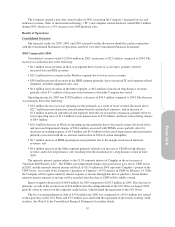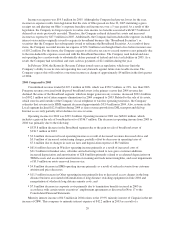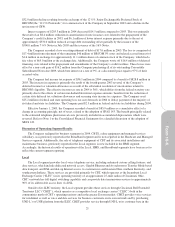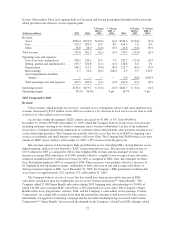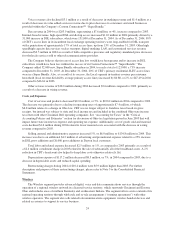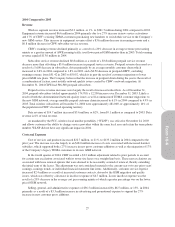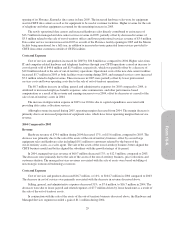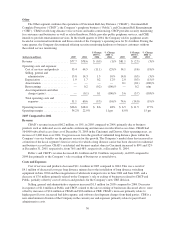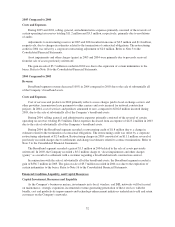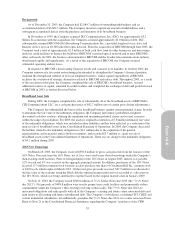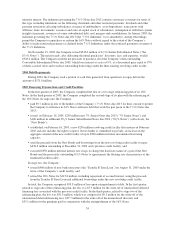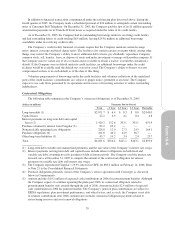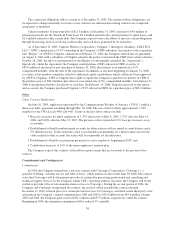Cincinnati Bell 2005 Annual Report Download - page 76
Download and view the complete annual report
Please find page 76 of the 2005 Cincinnati Bell annual report below. You can navigate through the pages in the report by either clicking on the pages listed below, or by using the keyword search tool below to find specific information within the annual report.encountered in 2004, and fourth quarter net activations (gross activations less deactivations) of 14,700 in
2005 compared favorably to a loss of net subscribers of 1,800 in the same period of 2004. Average churn
for the year was approximately 2.2%. However, churn declined over the course of the year from 2.8% in
the fourth quarter of 2004 to 1.8% in the fourth quarter of 2005. This was due to the resolution of the
aforementioned network problems and the introduction of more attractive rate plans;
•$1.7 million increase in prepaid service revenues primarily due to an increase in average subscribers. As
of December 31, 2005, prepaid subscribers totaled approximately 180,500, compared to 174,700 at
December 31, 2004. Prepaid ARPU was flat compared to 2004, as higher data ARPU offset lower voice
ARPU. Average monthly prepaid customer churn increased from 6.1% in 2004 to 6.5% in 2005 primarily
as a result of increased competition; and
•$9.4 million decrease in roaming revenue due to a decrease in minutes of use as a result of the merger
between Cingular and AT&T Wireless Services Inc. CBW has lost substantial roaming revenue as
Cingular customers are now using Cingular’s network versus CBW’s network. As part of CBW’s
agreement with Cingular, a substantial portion of this lost roaming revenue is offset by a rate reduction on
the cost of roaming minutes purchased from Cingular. For 2005, roaming expense decreased $8.9 million
compared to 2004.
Total wireless subscribers at December 31, 2005 were approximately 496,000, which represents
approximately 15% of the population in CBW’s licensed operating territory.
Equipment revenue increased by $3.0 million as the Company sold 41,000 more handsets during 2005 as
compared to 2004 as 26,000 more TDMA customers migrated to the Company’s GSM network.
Costs and Expenses
Cost of services and products consists largely of network operation costs, roaming expense (whereby CBW
incurs costs associated with its subscribers using their handsets while in the territories of other wireless service
providers), interconnection expenses, and cost of handsets and accessories sold. The decrease in costs of services
of $3.9 million compared to 2004 was due to lower roaming expense of $8.9 million resulting from the
renegotiation of rates with Cingular noted above, partially offset by $1.9 million of higher handset and accessory
costs related to the equipment revenue increase and $2.5 million of higher operating taxes.
Selling, general and administrative expenses include certain customer acquisition expenses, such as
advertising, distribution and promotional expenses. These expenses were flat as compared to 2004. Increases in
advertising and promotional expenses of $2.9 million were offset by decreased fees for outsourced services as a
result of better negotiated rates and lower legal claim costs for the roaming litigation that was incurred in 2004.
Refer to Note 11 to the Consolidated Financial Statements.
In 2005, the Company further revised its estimate of the remaining useful lives of certain of the TDMA
assets, resulting in additional depreciation. The depreciation increase for 2005 versus 2004 results from the
accelerated depreciation on TDMA assets as well as on certain GSM assets that were replaced in late 2005 as part
of the Company’s continued initiative to improve GSM network quality.
The Company incurred charges of $42.3 million in 2005 to write down the recorded value of its TDMA
network assets. A portion of the TDMA assets were taken out of service in 2005 in order to optimize the
remaining spectrum associated with TDMA assets. This resulted in a charge of $23.7 million. Additionally, an
asset impairment charge of $18.6 million was incurred to write down to fair value the remaining TDMA assets in
use. Due to the rapid migration of TDMA subscribers to the Company’s GSM network and lower ARPU
associated with the remaining TDMA customers, the remaining future cash flows associated with the TDMA
assets could no longer support the recorded value of the TDMA assets, resulting in the impairment charge. After
the charges, the book value of TDMA network assets was less than $1 million at December 31, 2005. The
Company expects to discontinue its TDMA network in 2006. Asset impairment charges in 2004 were recorded to
write-down certain TDMA assets taken out of service and certain intangible assets.
Amortization expense in 2004 was a result of accelerated amortization related to the change in estimated
economic useful life of certain roaming and trade name agreements as a result of the merger between Cingular
and AT&T Wireless Services on October 26, 2004.
26





